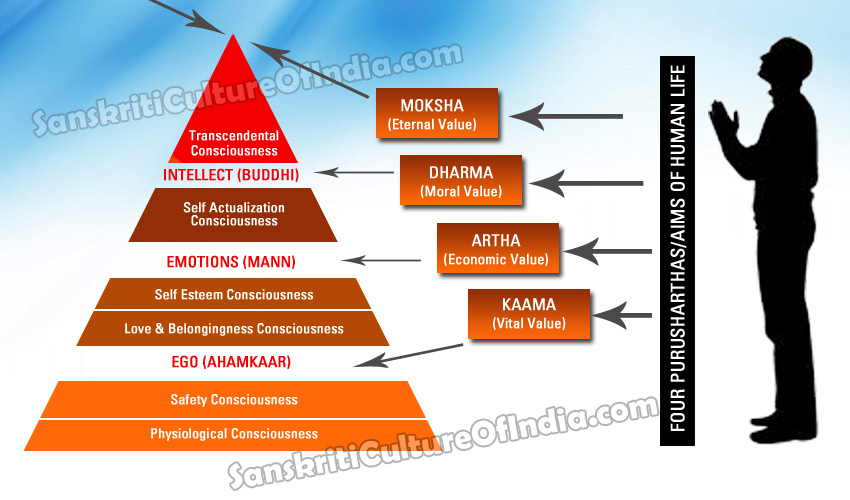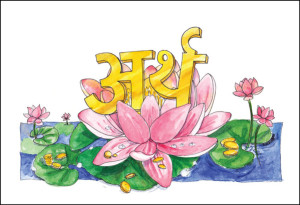Millennial ago, seers in the ancient Eastern tradition articulated the blueprint for the fulfillment of the objectives of human birth as was shown to them in the highest supreme levels of consciousness. The Supreme Self pervades and exists in all dimensions in all beings, sentient and insentient. It is that Supreme Self that exists inside each individual self, in each individual person. And therefore every individual person is none other than the Supreme Self, for how can the part be different from the whole.
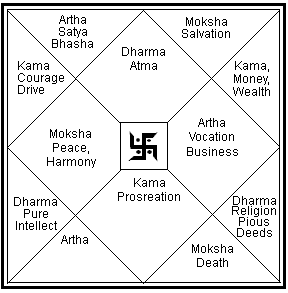 In order for an individual to realize their supreme Self, they need to identify the reasons and objectives why they came into being on this earth plane, and fulfill them. The ancient seers clearly articulated the objectives of humankind as “Purusharthas” — ‘Purusha’ means an individual or person, and ‘Artha’ means meaning or objective or pursuit. They articulated four Purusharthas as:
In order for an individual to realize their supreme Self, they need to identify the reasons and objectives why they came into being on this earth plane, and fulfill them. The ancient seers clearly articulated the objectives of humankind as “Purusharthas” — ‘Purusha’ means an individual or person, and ‘Artha’ means meaning or objective or pursuit. They articulated four Purusharthas as:
The four purusharthas are really the objectives of God, of the Supreme Self, the qualities of God. And since an individual person is a reflection of God, is a part of God, it is the rightful pursuit of a person to fulfill these four purusharthas. In fact, it is both your individual and soul purpose.
An individual can realize him or herself by balancing and fulfilling these four objectives. These four objectives are not independent of each other and should not be viewed in a stand-alone manner. They define and refine the other objectives and allow the other objectives to define and refine itself. The activity of fulfilling one objective should also support the fulfillment of the other objectives. By maintaining a balance between the definition and fulfillment of the four purusharthas, a symbiotic evolution of the individual self takes place. Exclusive pursuit of one purushartha creates an imbalance in a person’s life, and prevents the person from reaching the ultimate destination of their life. As a person progresses through the evolution of their soul, they find that some of the objectives eventually lose their place and importance to more predominant objectives. For example, the desire to earn wealth may diminish and disappear, or a person may come to the realization that there are no more material desires that they need to pursue, and hence more room is created for the pursuit of the ultimate objective, Moksha.
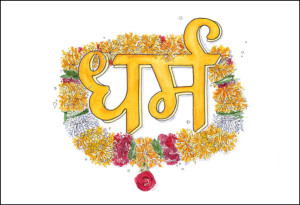 Dharma:
Dharma:
A person is born on this earth to perform certain duties. The soul houses itself into the physical vehicle that is the body which most suits for performing these duties. The physical work that a person needs to do, the duties of the person on this earth plane are termed as the Dharma of the person. Dharma is a difficult term to translate into English, but can roughly be translated as the rightful duty of a person. This is the true calling of a person, what they are born to do. Examples of a person’s dharma are to be a doctor, teacher, writer, warrior, priest, parent etc. Sometimes a person’s dharma is decided by their birth, but not necessarily so. A person’s dharma can be a combination of things, and as a person progresses through life, different stages of life may call for different dharmas and purposes. Tuning into the inner guide of the heart allows a person to identify their dharma, their true calling.
Artha:
Artha is the pursuit of material wealth, which brings material comforts to a person. People sometimes believe that the path of spiritual growth and pursuit of material wealth are mutually exclusive, or even that a spiritual seeker needs to be in poverty. But that is not true. If we look at the Universe, it is a reflection of abundance. Nature is abundant in everything, poverty is nothing but a state of consciousness. If abundance is the quality of the Divine, how is pursuit of abundance in contrast with the pursuit of the Divine? If one is in poverty, in a state of constantly worrying about how to support and feed, if that is what the focus is on, how can one pursue spirituality? Only when there are no worries is one able to focus their attention to the goal of union with the Divine. The important thing to remember is not to be attached to the possession or attainment of wealth. It can be either transcended or sought with detachment, and with awareness. When done in this state of mind, the pursuit of wealth is not different from the pursuit of the Divine, because one sees abundance, or wealth as a form of the Divine. And in this state of detachment, one recognizes when one has attained their financial objectives, and hence the desire to pursue automatically dies away, paving the way for Moksha.
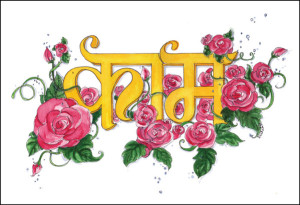 Kama:
Kama:
Kama is fulfilling one’s desires. Desires are in various forms — to be wealthy, powerful, sexual needs, recognition, service, etc. The Kama purushartha advocates that one’s desires in this lifetime need to be fulfilled, albeit in a state of awareness and without harming anyone in the process. For a person to evolve spiritually and to reach the ultimate destination, the barrier of desires needs to be crossed. This can be done either by fulfilling the desires, or by sublimating or transcending them. Suppressing of desires is certainly not recommended because it is like a fully coiled spring that is held down by force, it can erupt unpredictably causing undesirable consequences. As one becomes aware of their desires and one goes about fulfilling them in awareness and without judgement, one soon reaches the stage of being able to sublimate them. The Divine, the Universe, lends a big hand in the process.
Moksha:

Moksha means liberation, realization of the Self, and is the ultimate destination of this human birth. It is the stage of inner realization that the individual self is the same as the Supreme Self. It is the experience of the cosmos within one’s self. It is the experience of the flow and fusion of the Shiva and Shakti energies in one’s self. It is the experience of union, oneness, Ekatvam, with the Universe.
As all the rivers must eventually lead to the sea, there are many spiritual paths leading to the same destination. Some paths are shorter than others, some are more arduous than others. The path can be difficult to navigate, and the path may not always be visible. A guide, in the form of a Guru is needed to traverse this path, someone who holds the person and shows them the Way to their inner Guru.
~ Ekatvam
~ Art by Ruchita Madhok

